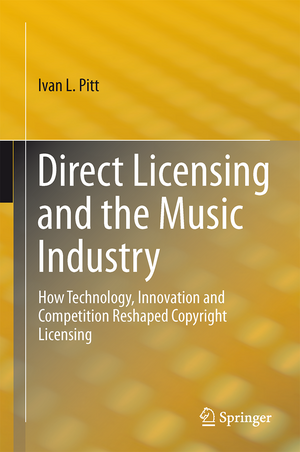Direct Licensing and the Music Industry: How Technology, Innovation and Competition Reshaped Copyright Licensing
Autor Ivan L Pitten Limba Engleză Hardback – 22 aug 2015
| Toate formatele și edițiile | Preț | Express |
|---|---|---|
| Paperback (1) | 560.62 lei 38-44 zile | |
| Springer International Publishing – 22 oct 2016 | 560.62 lei 38-44 zile | |
| Hardback (1) | 653.14 lei 3-5 săpt. | |
| Springer International Publishing – 22 aug 2015 | 653.14 lei 3-5 săpt. |
Preț: 653.14 lei
Preț vechi: 768.40 lei
-15% Nou
Puncte Express: 980
Preț estimativ în valută:
124.98€ • 130.84$ • 103.41£
124.98€ • 130.84$ • 103.41£
Carte disponibilă
Livrare economică 17-31 martie
Preluare comenzi: 021 569.72.76
Specificații
ISBN-13: 9783319176529
ISBN-10: 3319176528
Pagini: 250
Ilustrații: XXV, 293 p. 8 illus. in color.
Dimensiuni: 155 x 235 x 22 mm
Greutate: 0.77 kg
Ediția:1st ed. 2015
Editura: Springer International Publishing
Colecția Springer
Locul publicării:Cham, Switzerland
ISBN-10: 3319176528
Pagini: 250
Ilustrații: XXV, 293 p. 8 illus. in color.
Dimensiuni: 155 x 235 x 22 mm
Greutate: 0.77 kg
Ediția:1st ed. 2015
Editura: Springer International Publishing
Colecția Springer
Locul publicării:Cham, Switzerland
Public țintă
ResearchCuprins
I Part One: How Direct Licensing Increased Competition.- 1Introduction .- 2 Copyright Law and Natural Monopolies.- 3 Traditional BlanketLicense.- 4 Direct Licensing as an Alternative to the Traditional BlanketLicense.- 5 Conclusion.- II Part Two: Why Putting Music Content Creators Firstis Important.- 6 Introduction.- 7 Roles of Publishers, Record Labels andProducers.- 8 Possible New Entrant.- 9 Why The Merger Could Be A Viable Option.-10 Conclusion.
Textul de pe ultima copertă
This book discusses the economics of the music industry in the context of the changing landscape brought about by innovation, technological change, and rapid digitization. The ability of digital technology to reduce the transaction costs of music copyright licensing has all but destroyed the traditional media business models of incumbent Performance Rights Organizations (PROs), music publishers, record labels, and radio and television stations. In a climate where streaming services are rapidly proliferating and consumers prefer subscription models over direct ownership, new business models, such as direct licensing, are developing. This book provides an overview of the economics of the traditional music industry, the technology-induced changes in business models and copyright law, and the role of copyright holders such as music publishers, record labels, songwriters and composers in the emerging direct licensing models. In Part One, the author examines the economic aspects of directlicensing as an alternative to the traditional blanket license for copyrighted musical compositions, with an emphasis on the often monopolistic nature of PROs and the economic barriers to entry preventing new competitors from emerging in the industry. In Part Two, the author focuses on the music publisher and the role direct licensing and competition may play in the changing business models in the music industry and the potential benefits this may bring to copyright holders, such as songwriters. To compliment this model, the author proposes a maximum statutory fixed-rate for the licensing of musical performances in the pending future changes to the Copyright Act and Consent Decrees to further streamline the performance royalty payment process, especially where distributors such as Google and YouTube are concerned. This book adds to the growing body of literature on the economics of music licensing in the digital age. It will be useful to those in the fields of economics and law, as well as music executives, musicians, songwriters, composers, and other industry professionals who are interested in understanding how technology, innovation and competition have reshaped the music industry.
Caracteristici
Examines a selection of the new publishing business models in the music industry and the role of direct licensing in creating a competitive market for copyright administration Illustrates how technology, innovation and competition have reshaped the music industry Proposes a maximum statutory fixed-rate for musical performances?




















